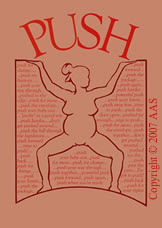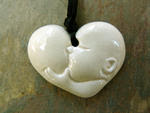The Cochrane study that showed epidural does NOT contribute to increased cesarean section rates has been used by many to support the continued increasing use of epidural anesthesia, and in some cases it is used to bash natural birth advocates. A physician reviews the Cochrane Study and points out the flaws that led to misreporting.
Can Fam Physician. 2006 April 10; 52(4): 419–421.
Copyright © 2006, Can Fam Physician
Does epidural analgesia increase rate of cesarean section?
Michael C. Klein, MD, CCFP, FAAP, FCFP
Epidural analgesia (EA) is clearly the most effective form of pain relief during labour.1 But various unwanted side effects are associated with its use,2 including longer labour; increased incidence of maternal fever (with associated increase in use of antibiotics for mothers and newborns); and increased rates of operative vaginal delivery and perineal trauma,2 such as more third- and fourth-degree tears.3,4
The 2000 Cochrane meta-analysis2 that compared EA with narcotics did not show increased rates of cesarean section (CS) associated with EA. For many practitioners this came as a surprise; in practice EA certainly seemed to increase rates of CS, especially when used before the active phase of labour. Earlier studies5,6 had shown a modest increase in rates of CS when EA was compared with other methods of analgesia. One trial showed such a large effect that the trial had to be stopped.6"
I have to insert my own rant here. UNBORN and NEWBORNS BABIES are the UNINFORMED AND NON CONSENTING SUBJECTS in any research done that divides laboring and birthing women into subject groups to receive different drug treatments. Drugs that have never been shown to be safe for the birthing baby, but are shown to be detrimental to adult populations.
Sorry, I wish I could credit to the following quotes - but I can't find the source, but I am looking:
(found another reference: http://sci.rutgers.edu/forum/showthread.php?t=1663)
Russia's top health official Yuri Shevchenko reported that the gas used in the storming of a Moscow theater held by Chechen gunmen was based on fentanyl, a fast-acting opiate with medical applications. Shevchenko said the deaths were caused by the use of the chemical compound on people who had been starved of oxygen, were dehydrated, hungry, unable to move adequately and under severe psychological stress.
Injected, skin-patch and oral doses of fentanyl sold in the United States carry warnings that the anesthetic can be fatal if administered in too high a dose and that doses must be customized, taking into account the patients' size and any previous exposure to similar drugs.
Fentanyl was among drugs that Pennsylvania State University researchers suggested two years ago that the U.S. military explore as weapons to subdue angry mobs. The Pentagon has put such research on hold, however, because of worries that it would violate the international ban on chemical weapons.
Fentanyl is one of the drugs used in epidural anesthesia for childbirth ("hungry, unable to move adequately, under severe psychological stress" sounds familiar). It certainly has worked wonders on the women of this culture as a chemical weapon in the war against spontaneous, unimpeded, empowered birthing.
Scaaaaaary, eh? And, then considering the unregulated, unsupervised, non-medically necessary induction of labor with artificial hormones that leads to the need for epidural, remember a post a few weeks ago about the study on trust and decision making where researchers found that the use of oxytocin spray made people trust unknown people with their money? Draw your own conclusions about the full extent of the use of oxytocin to induce or augment labor and have women "go stupid" as one woman put it.
Hormone Spray Is Found To Bolster Trust in OthersPotential to Ease Relationship Disorders, Cited By Shankar Vedantam, Washington Post Staff WriterThursday, June 2, 2005; Page A03
Scientists have found the chemical equivalent of the perfect salespitch: a hormone that makes us more trusting than we normally are.
Volunteers in a study were told they were participating in adecision-making experiment. Those who inhaled the hormone, which occurs naturally in the brain, were more likely to entrust others with large sums of money than were volunteers who inhaled no hormone. The experiment has profound implications about the nature of human trust.
The experiment, involving 128 participants, was conducted by scientistsat the University of Zurich and other academic centers. Researchers had some volunteers inhale oxytocin and then examined how they and those who inhaled a placebo invested money in a mock transaction. The transaction involved taking a risk: handing over money to a"banker" who had the option of returning the investment with a profitor withholding principal and profit, leaving the investor with nothing. The experiment was a measure of the trust that the investors had in the bankers.
Volunteers who inhaled oxytocin were more likely to trust the banker with money and risk larger sums, the researchers said in an article published yesterday in the journal Nature.
So, the use of a hormone known to increase trust in strangers is used routinely before the use of a subduing drug that the government classifies as chemical weapon and says is difficult to regulate because of body size and physiological history (Oh, say, like if a woman has been on other drugs prior to or during pregnancy? or was born under anesthesia and had previous surgeries?) And, remember, that fentanyl was combined with bupivacaine to control the negative effects of bupvicaine in early epidurals. AGAIN, this was done "scientifically" in research where some babies had one and some had the other and the "synergistic" combination -- to discover WHICH was safER. !?! When the drugs are known to be dangerous for anyone? And then there's ketamine, an animal tranquilizer in the cesarean cocktail giving to women birthing surgically. Who and where are these young adults now who were born "under the influence" of epidural since the late eighties? No one cares to look at the long term effects of these violations and drugs at birth in order to resolve the increasing psychological and behavior issues of our youth.
Add these alarming awarenesses of how drugs are used to control women from pre-labor and beyond, to the article Michael Greger, MD and United Progressive Alumni[ Medical School Resources Appendices Discussion ] also posted here earlier about violating women under anesthesia.
I am all gloved up, fifth in line. At Tufts, medical students - particularly male students - practice pelvic exams on anesthetized women without their consent and without their knowledge. Women come in for surgery and, once they're asleep, we all gather around; line forms to the left.
In the medical ethics literature this practice has been called, "an outrageous assault upon the dignity and autonomy of the patient...."[120] "The practice shows a lack of respect for these patients as persons, revealing a moral insensitivity and a misuse of power."[121] "It is just another example of the way in which physicians abuse their power and have shown themselves unwilling to police themselves in matters of ethics, especially with regard to female patients."[122]
We learn more than examination skills. Taking advantage of the woman's vulnerability - as she lay naked on a table unconscious - we learn that patients are tools to exploit for our education.
It's beyond scary, it's terrifying and violating what is happening to women and babies (and the fathers) in the US medical machine. Thankfully, now some physicians, mostly family practice physicians, are publicly saying what "natural birth" advocates have been saying. Drugs at birth cause more interventions, disruptions, and complications. Birth in the hospital is NOT SAFE BECAUSE OF THE DRUGS.
So, back to Dr. Klein. One of his comment/conclusions is:
The Cochrane meta-analysis of EA has inadvertently increased use of EA, and has therefore increased continuous electronic fetal monitoring; kept more women in bed (usually with an intravenous drip); and led to more instrumentation, more perineal trauma, an increase in the CS rate, and, likely, more feelings of failure among mothers. It will also lead, because of the increase in CS, to an increase in problems with placentas in future pregnancies (previa, accreta, percreta, abruption),19 infertility,20 and ectopic pregnancies.19 This is unexpected collateral damage that contributes to overuse of technology during childbirth. It has even led some to suggest that, since childbirth is already so unnatural, CS on request is not such an unreasonable idea—a surgical solution for a non-surgical problem.21-23.
http://www.pubmedcentral.nih.gov/articlerender.fcgi?tool=pmcentrez&artid=1481670
Thanks, Docs!
I'd like to note that this research was done in Canada where it might be that physicians have a different relationship with drug companies than do doctor's here. Most of the research looking at epidural usage or effects of the drugs are done outside of the United States.
And have you noticed that the Family Practice physicians -- who are not surgeons -- support a more natural, medically supported way of birthing as well as midwifery care?? I know a family practice physician who does only birth center and homebirth and her malpractice was $11,000 per year. I know an OB trained family practice physician who did not practice as an OB after all because of the cost of malpractice insurance to practice privately. Hospitals must include malpractice in the package or physicians can't afford it -- $100,000 a year in Illinois. To work in the hospital means one must generate money to pay for the system and insurance, which means more interventions and surgery which means more malpractice litigation and insurance premiums.
As Upton Sinclair says, It's difficult to get a man to understand something when his salary depends upon his not understanding it.
It's not in an obstetrician's financial and professional interest to support natural birth; however, obstetricians certainly have their rightful and esteemed place, as in the UK -- the amazing ability to save the lives of high risk women and babies. Why isn't that enough in the US?
The Other Side of the Glass
Part One was officially released June 2013 in digital distribution format.
To purchase to to www.theothersideoftheglass.com
If you were a donor and want to download your copy send an email to theothersideoftheglassfilm@gmail.com.
The trailer
Subscribe to:
Post Comments (Atom)
"Soft is the heart of a child. Do not harden it."
A public awareness reminder that things that happen behind the scenes, out of our sight, aren't always as rosy as we might think them to be. Perhaps its a restaurant cook who accidentally drops your burger
on the floor before placing it on the bun and serving it to you. Here it's an overworked apathetic (pathetic) nurse giving my newborn daughter her first bath.
Please comment and rate this video, so as to insure that it is viewed as widely as possible, perhaps to prevent other such abuse. -- The mother who posted this YouTube. How NOT to wash a baby on YouTube
Are you going to try to tell me that "babies don't remember?" There is no difference to this baby's experience and the imprinting of her nervous system/brain and one that is held and cleaned by the mother or father either at the hospital or at home?
By the way, this is probably NOT the baby's first bath. The nurse is ungloved. Medical staff protocol is that they can't handle a baby ungloved until is has been bathed (scrubbed if you've seen it) because the baby is a BIO-HAZARD -- for them. Never mind that the bio-hazard IS the baby's first line of defense against hospital germs.
Missouri Senator Louden Speaks
Finally, A Birth Film for Fathers
Part One of the "The Other Side of the Glass: Finally, A Birth Film for and about Men" was released June, 2013.
Through presentation of the current research and stories of fathers, the routine use of interventions are questioned. How we protect and support the physiological need of the human newborn attachment sequence is the foundation for creating safe birth wherever birth happens.
Based on knowing that babies are sentient beings and the experience of birth is remembered in the body, mind, and soul, fathers are asked to research for themselves what is best for their partner and baby and to prepare to protect their baby.
The film is designed for midwives, doulas, and couples, particularly fathers to work with their caregivers. Doctors and nurses in the medical environment are asked to "be kind" to the laboring, birthing baby, and newborn. They are called to be accountable for doing what science has been so clear about for decades. The mother-baby relationship is core for life. Doctors and nurses and hospital caregivers and administrators are asked to create protocols that protect the mother-baby relationship.
Men are asked to join together to address the vagaries of the medical system that harm their partner, baby and self in the process of the most defining moments of their lives. Men are asked to begin to challenge the system BEFORE they even conceive babies as there is no way to be assured of being able to protect his loved ones once they are in the medical machine, the war zone, on the conveyor belt -- some of the ways that men describe their journey into fatherhood in the medicine culture.
Donors can email theothersideoftheglassfilm@gmail.com to get a digital copy.
Through presentation of the current research and stories of fathers, the routine use of interventions are questioned. How we protect and support the physiological need of the human newborn attachment sequence is the foundation for creating safe birth wherever birth happens.
Based on knowing that babies are sentient beings and the experience of birth is remembered in the body, mind, and soul, fathers are asked to research for themselves what is best for their partner and baby and to prepare to protect their baby.
The film is designed for midwives, doulas, and couples, particularly fathers to work with their caregivers. Doctors and nurses in the medical environment are asked to "be kind" to the laboring, birthing baby, and newborn. They are called to be accountable for doing what science has been so clear about for decades. The mother-baby relationship is core for life. Doctors and nurses and hospital caregivers and administrators are asked to create protocols that protect the mother-baby relationship.
Men are asked to join together to address the vagaries of the medical system that harm their partner, baby and self in the process of the most defining moments of their lives. Men are asked to begin to challenge the system BEFORE they even conceive babies as there is no way to be assured of being able to protect his loved ones once they are in the medical machine, the war zone, on the conveyor belt -- some of the ways that men describe their journey into fatherhood in the medicine culture.
Donors can email theothersideoftheglassfilm@gmail.com to get a digital copy.
Buy the film at www.theothersideoftheglass.com.
The film focuses on the male baby, his journey from the womb to the world and reveals healing and integrating the mother, father, and baby's wounded birth experience. The film is about the restoring of our families, society, and world through birthing loved, protected, and nurtured males (and females, of course). It's about empowering males to support the females to birth humanity safely, lovingly, and consciously.
Finally, a birth film for fathers.
The film focuses on the male baby, his journey from the womb to the world and reveals healing and integrating the mother, father, and baby's wounded birth experience. The film is about the restoring of our families, society, and world through birthing loved, protected, and nurtured males (and females, of course). It's about empowering males to support the females to birth humanity safely, lovingly, and consciously.
Finally, a birth film for fathers.
What People Are Saying About the FIlm
Well, I finally had a chance to check out the trailer and .. wow! It's nice that they're acknowledging the father has more than just cursory rights (of course mom's rights are rarely acknowledged either) and it's great that they're bringing out the impact of the experience on the newborn, but I'm really impressed that they're not shying away from the political side.
They are rightly calling what happens in every American maternity unit, every day, by its rightful name - abuse. Abuse of the newborn, abuse of the parents and their rights, abuse of the supposedly sacrosanct ethical principal of patient autonomy and the medico-legal doctrine of informed consent, which has been long ago discarded in all but name. I love it!
In the immortal words of the "shrub", "bring it on!" This film needs to be shown and if I can help facilitate or promote it, let me know.
Father in Asheville, NC
Thanks for sharing this. It was very touching to me. I thought of my brother-in-law standing on the other side of the glass when my sister had to have a C-section with her first child because the doctor was missing his golf date. I'll never forget his pacing back and forth and my realizing that he was already a father, even though he hadn't been allowed to be with his son yet.
Margaret, Columbia, MO
They are rightly calling what happens in every American maternity unit, every day, by its rightful name - abuse. Abuse of the newborn, abuse of the parents and their rights, abuse of the supposedly sacrosanct ethical principal of patient autonomy and the medico-legal doctrine of informed consent, which has been long ago discarded in all but name. I love it!
In the immortal words of the "shrub", "bring it on!" This film needs to be shown and if I can help facilitate or promote it, let me know.
Father in Asheville, NC
OMG'ess, I just saw the trailer and am in tears. This is so needed. I watch over and over and over as fathers get swallowed in the fear of hospitals birth practice. I need a tool like this to help fathers see how very vital it is for them to protect their partner and baby. I am torn apart every time I see a father stand back and chew his knuckle while his wife is essentially assaulted or his baby is left to lie there screaming.
Please send me more info!!!!
Carrie Hankins
CD(DONA), CCCE, Aspiring Midwife
720-936-3609
Thanks for sharing this. It was very touching to me. I thought of my brother-in-law standing on the other side of the glass when my sister had to have a C-section with her first child because the doctor was missing his golf date. I'll never forget his pacing back and forth and my realizing that he was already a father, even though he hadn't been allowed to be with his son yet.
Margaret, Columbia, MO
In case you don't find me here
Soon, I'll be back to heavy-duty editing and it will be quiet here again. I keep thinking this blog is winding down, and then it revives. It is so important to me.
I wish I'd kept a blog of my journey with this film this past 10 months. It's been amazing.
I have a new blog address for the film, and will keep a journal of simple reporting of the journey for the rest of the film.
www.theothersideoftheglassthefilm.blogspot.com
I'll be heading east this week to meet with a group of men. I plan to post pictures and clips on the film blog.
I'll keep up here when I can -- when I learn something juicy, outrageous, or inspiring related to making birth safer for the birthing baby.
I wish I'd kept a blog of my journey with this film this past 10 months. It's been amazing.
I have a new blog address for the film, and will keep a journal of simple reporting of the journey for the rest of the film.
www.theothersideoftheglassthefilm.blogspot.com
I'll be heading east this week to meet with a group of men. I plan to post pictures and clips on the film blog.
I'll keep up here when I can -- when I learn something juicy, outrageous, or inspiring related to making birth safer for the birthing baby.
Review of the film
Most of us were born surrounded by people who had no clue about how aware and feeling we were. This trailer triggers a lot of emotions for people if they have not considered the baby's needs and were not considered as a baby. Most of us born in the US were not. The final film will include detailed and profound information about the science-based, cutting-edge therapies for healing birth trauma.
The full film will have the interviews of a wider spectrum of professionals and fathers, and will include a third birth, at home, where the caregivers do a necessary intervention, suctioning, while being conscious of the baby.
The final version will feature OBs, RNs, CNMs, LM, CPM, Doulas, childbirth educators, pre and perinatal psychologists and trauma healing therapists, physiologists, neurologists, speech therapists and lots and lots of fathers -- will hopefully be done in early 2009.
The final version will include the science needed to advocated for delayed cord clamping, and the science that shows when a baby needs to be suctioned and addresses other interventions. Experts in conscious parenting will teach how to be present with a sentient newborn in a conscious, gentle way -- especially when administering life-saving techniques.
The goal is to keep the baby in the mother's arms so that the baby gets all of his or her placental blood and to avoid unnecessary, violating, and abusive touch and interactions. When we do that, whether at home or hospital, with doctor or midwife, the birth is safe for the father. The "trick" for birthing men and women is how to make it happen in the hospital.
The full film will have the interviews of a wider spectrum of professionals and fathers, and will include a third birth, at home, where the caregivers do a necessary intervention, suctioning, while being conscious of the baby.
The final version will feature OBs, RNs, CNMs, LM, CPM, Doulas, childbirth educators, pre and perinatal psychologists and trauma healing therapists, physiologists, neurologists, speech therapists and lots and lots of fathers -- will hopefully be done in early 2009.
The final version will include the science needed to advocated for delayed cord clamping, and the science that shows when a baby needs to be suctioned and addresses other interventions. Experts in conscious parenting will teach how to be present with a sentient newborn in a conscious, gentle way -- especially when administering life-saving techniques.
The goal is to keep the baby in the mother's arms so that the baby gets all of his or her placental blood and to avoid unnecessary, violating, and abusive touch and interactions. When we do that, whether at home or hospital, with doctor or midwife, the birth is safe for the father. The "trick" for birthing men and women is how to make it happen in the hospital.








1 comment:
I had heard of the vaginal exams of women under general anesthesia. In my mind and ick-ed out heart it feels/sounds like rape. I didn't consent to that touch and did not want it - get your rubber finger out of me.
It literally makes me nausea.
Bunches of good information here.
Post a Comment